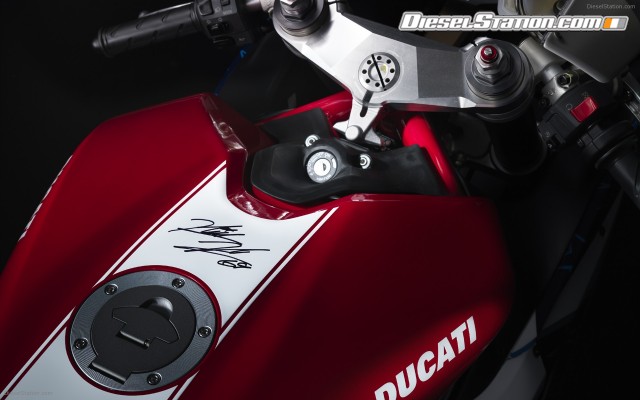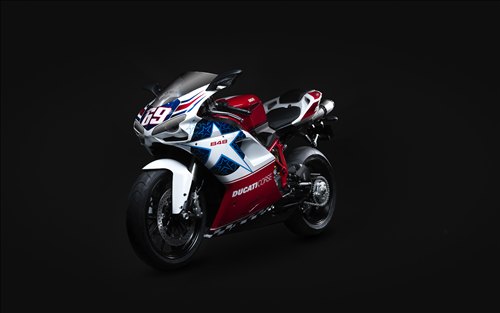Ducati unveiled the new for 2010 Nicky Hayden edition 848 for the US market at Red Bull United States Grand Prix at Mazda Raceway Laguna Seca.
Nicky Hayden Edition 848 is the 2010 model of Ducati’s middleweight sport bike and the paint work recreates part of Nicky Hayden’s helmet design. A total of approximately 100 units are destined to be sold in US making sure each owner stands out in the croud from other Ducati and each bike will feature Nicky Hayden’s personal autograph on the fuel tank.
The new Special Edition 848 ushers in a revised LED dash cluster for better visibility, optional 30mm mirror extensions, improved aluminum cam belt tensioner pulleys for lower weight and a redesigned crankcase. The bike features the same 134-horsepower L-twin Evoluzione powerplant, wet-clutch and six-speed gearbox as the rest of the 848 line with a total weight of mere 168kgs.
848 Nicky Hayden Special Edition will be priced at $14,499 which is $500 more than the current 848 pricing.
Ducati 848 Nicky Hayden Edition
Nicky Hayden
Ducati North America is proud to announce the 848 Nicky Hayden Edition. This striking livery places a distinctly American stamp on the market's best middleweight sport bike. We are excited to unveil this model in conjunction with the Red Bull United States Grand Prix at Mazda Raceway Laguna Seca, as there is no better time to celebrate the American World Champion than at his home race on the 4 th of July. This US-exclusive model features an American inspired paint scheme, aptly fit for its introduction on the 4 th of July, personally autographed gas tank, and model updates for the 2010 year. MSRP is $14,495, and will be available July 7 at authorized Ducati dealers.
So light, but so powerful
The new Ducati 848 Nicky Hayden Edition enjoys all the performance advancements of the entire Superbike family, while adding its own innovations to redefine the middleweight sport bike class.
The words ‘agile' and ‘refined' aptly describe the 848. At 168kg (369lbs) the 848 is an amazing 20kg (44lbs) lighter than its predecessor, and a significant 5kg (11lbs) lighter than its larger capacity brother, the 1098.
The highly advanced 848 engine uses an improved method of engine case production in which cases are vacuum die-cast formed. While providing significant weight savings of more than 3kg (6.5lbs), this method also ensures consistent wall thickness and increased strength. Further refinements include a sophisticated wet clutch that offers 1kg (2.2lbs) less weight, a much higher service life, improved clutch feel and quiet operation.
With the first twist of the wrist, the powerful rush of the Testastretta Evoluzione engine confirms that the rules have changed. The 848's 134hp is not only 30% more powerful than its predecessor, but it provides a power-to-weight ratio even better than the potent 999.
New for 2010:
Available immediately, the 848 Nicky Hayden Edition is the first of the 2010 Ducati 848 models to arrive in showrooms. For 2010, this model features several upgrades in addition to the special Hayden livery and full specifications listed below, including:
• LED dash illumination for better visibility – particularly at night
• Inclusion of a 30mm mirror extension kit, enabling a choice of two stem lengths for better vision
• Aluminium cam belt tensioner pulleys to reduce weight and moving mass; in turn enabling better acceleration.
Engine
The 848 Testastretta Evoluzione engine becomes the benchmark for the middleweight sportsbike category, benefitting from all the experience accumulated with the larger engine on the 1198. It successfully adopts the same design guidelines and the same compact cylinder and cylinder head layout, but introduces for the first time ever an innovative solution for the crankcase, which has been designed with a further weight reduction for this advanced engine in mind. The overall layout of this engine integrates a series of avant-guard solutions, confirming the close links with the experience of Ducati's racing department.
The 849cc engine has bore and stroke values of 94mm and 61.2mm respectively, which produce a ratio that is only slightly inferior to the 1098 (1.54 compared with 1.61), while maintaining the highly ‘over-square' layout typical of racing engines.
Power output is an impressive 134hp (98.5kW) at 10,000 rpm and maximum torque is 71 lb/ft (96Nm) at 8250 rpm. The power and torque values confirm the high performance level of this engine, especially when compared to its predecessor, the Testastretta-engined 749.
The cylinder head has been modified in line with the characteristic bore and stroke of the engine in order to optimize the fluid dynamics of the intake (straight and plunging) and exhaust ducts and combustion chamber. The compression ratio is 12:1.
The valve angle is the same as the 1198 engine and diameter is 39.5mm for the inlet valve and 32mm for the exhaust. The technology used sees the application of a bi-metallic alloy that combines increased lightness with resistance and reliability required for these particular components. The desmodromic control system has also been designed with the weight and the inertia of the new components in mind, allowing extremely efficient valve lift during intake and exhaust phases. The excellent results achieved are confirmed by the engine's power figures, producing outstanding performance thanks also to the use of MotoGP-derived elliptical throttle bodies, which have been fitted to the 1198 engine. The 2010 model year sees the addition of new lightweight cam belt tensioner pulleys; improving performance while shaving weight.
The design of a dedicated elliptical throttle body for the 848 demonstrates the attention that Borgo Panigale engineers have devoted to the development of the Superbike range. The cross-section is reduced from the 60 sq. mm of the 1098 to 56 sq. mm so as to optimize fluid dynamics at every engine speed. Just like on the 1098, the new cylinder heads benefit from fewer components and include magnesium covers.
This Testastretta Evoluzione engine sees the introduction of a special technology for the construction of the engine crankcase: Vacural casting. This is a forced vacuum die casting method that allows jet characteristics to be improved thanks to the absence of porosity, gas inclusion and oxidation. This allows extremely high measurement precision and greater ductility for aluminium alloy. Designers have been able to harness the benefits of this innovative process by redefining the shape and the wall thickness of the new crankcase by means of FEA (Finite Element Analysis) checks, which allowed the required reliability standards to be achieved, while simultaneously obtaining a significant weight saving of 3.5kg.
The 848 engine is fitted with a silent modular wet clutch, characterized by an exceptional resistance to wear that will lead to superior duration. This solution makes a useful contribution to weight saving, estimated to be around 1.6kg, which is also due to the use of a different type of clutch cover.
The high power figures achieved by this engine also come from the use of the same type of oil cooler and coolant radiator as the 1198's engine, with an increased surface area assisted by lightweight, high flow electric fan assemblies.
Finally, the 848's exhaust system follows the same layout and uses the same innovative technology as the 1198. The system terminates with Ducati's trademark twin under-seat silencers, delivering the unmistakable signature sound of the big bore 90° L-Twin.
This power unit, just like all the other Ducati engines, has been designed to comply with Euro 3 exhaust emission norms.
Chassis
Trellis frame
Developed in cooperation with Ducati Corse, the 848 Trellis frame has a simplified tube layout featuring main section tubes increased in diameter from 28mm to 34mm, while being reduced in thickness from 2mm to 1.5mm. The result is a 14% increase in rigidity and a weight saving of 1.5kg (3.3lbs).
Single-sided swingarm
The 848, as all the Superbike family, is equipped with a unique single-sided swingarm. The engineers were encouraged to re-think the construction technique of this element. The solution was to produce the main operational components using individual aluminium castings so as to ensure strength around the pivot points, wheel hub and suspension links, with fabricated aluminium sections used to complete the construction into a single, beautifully engineered component.
Rear suspension
Highlighting the way in which individual components are influenced by each other, the new lightweight Trellis frame and single-sided swingarm have enabled a more compact and further weight-saving rear suspension linkage system to be used featuring separate lower pick-up points for the push-rod and suspension unit. This ‘tandem' design effectively reduces stress around the linkage pick-up area of the Trellis frame. Working together with this highly efficient linkage is a fully adjustable Showa single shock for the 848, the same as the 1198.
Front suspension
At the front the 848 is equipped with fully adjustable 43mm Showa forks with radial mounts. This type of front suspension is professionally track-tuned and offers superior road holding, delivers superior feedback, and helps every rider to be more confident and in control.
Control
Brembo Monobloc calipers
The 848 brake system is characterized by M4 calipers using four 32mm pistons and two radial mounted pads. Matched to the calipers are two 320mm discs and the combination of these elements achieves spectacular braking power.
Super lightweight wheels
The 848 also benefits from lightweight Marchesini Y-shaped spoke wheels. The weight saving of 250gr achieved on the front wheel substantially reduces the moment of inertia and enhances the 848's change of direction and braking performance. The rear wheel is just as impressive with a complete redesign for its single-sided swingarm application that has resulted in a reduction of over 1kg compared with traditional Ducati single-sided swingarm fitments. Finally a 5.50” wheel fitted with a 180/55 tyre guarantees the maximum agility at the rear.
Electronics
Desmosedici-style digital instrumentation is taken from Ducati's MotoGP GP9 project; and for 2010 now features LED backlighting for better visibility . This pure racing, minimalist solution has no switches or buttons to compromise its clean lines. Instead, information additional to the default read-outs is managed by handlebar-mounted switch gear, allowing the rider to scroll through and select from various menus. The default read-out presents rpm and speed, with the former displayed across the screen in a progressive bar graph. Optionally, the rpm and speed can be displayed in numeric values. The instrument display also doubles as a control panel for the activation of the data acquisition system as well as listing lap times recorded by using the high-beam flash button as a stopwatch.
With the purchase of the Ducati Data Analyser (DDA), which includes PC software, a USB-ready data retrieval card and instructions, owners are ready to review and analyse the performance of the bike and its rider, and make comparisons between various channels of information. The DDA is available from Ducati Performance.
Normally used on race bikes only, the system records numerous channels of data including throttle opening, vehicle speed, engine rpm, engine temperature, distance travelled, laps and lap times. The system also automatically calculates engine rpm and vehicle speed data so as to also display gear selection as an additional channel of information. At the end of a ride or track session, up to 2mb (approximately 3.5 hours) of data can be downloaded to your PC ready to compare, analyse and get an inside view of you and your 848's performance.
Data can be analysed in graphic form with options to zoom into detail of specific sections. Dragging a trace along a timeline to reveal individual values of the above listed channels enables the user to analyse performance in the same way that data technicians are able to do in factory teams.













































